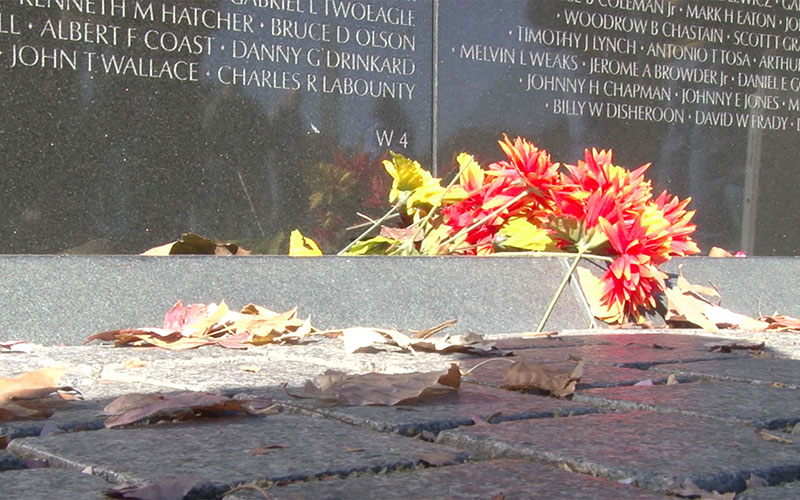
Almost 5.6 million visitors came to the Vietnam Veterans Memorial in 2015, making it the second-most visited site on the National Mall, after the Lincoln Memorial. (Photo by Dillion Eddie/Cronkite News)

Visitors have left thousands of mementos at the Vietnam Veterans Memorial over the years, from military paraphernalia to personal notes. (Photo by Dillion Eddie/Cronkite News)

Kimberly Allen said she was struck by the average age, about 20, of the more than 58,000 war dead whose names are inscribed on the Vietnam Veterans Memorial. (Photo by Dillion Eddie/Cronkite News)

More than 58,000 names of Americans killed in the Vietnam War are inscribed on the black granite wall that is the center of the Vietnam Veterans Memorial. (Photo by Dillion Eddie/Cronkite News)

The Vietnam Veterans Memorial wall as the sun rises over the Washington Monument on the National Mall. The wall, now popular, was thought to be too depressing by some when it opened. (Photo by Dillion Eddie/Cronkite News)
WASHINGTON – It’s been more than 50 years since the United States sent troops to Vietnam, and more than 30 years since a memorial on the National Mall was dedicated to honor soldiers in that war.
But for Kimberly Allen, a tourist visiting the Vietnam Veterans Memorial this week, the important number is 20 – what she says is the average age of the people whose names are engraved on the black granite wall.
“The average age on that wall is 20 years old and the youngest person I think is 15,” said Allen.
The Vietnam Veterans Memorial wall in Washington D.C. was opened in 1984 to honor the men and women who served in the Vietnam War. The main feature of the memorial is the V-shaped black wall, cut into the earth, on which are etched the names of more than 58,000 men and women who gave their lives in what was an unpopular war.
See related story:
Controversial at the time – some veterans said the wall was reminiscent of a giant tombstone – the Vietnam Veterans Memorial Fund which raised money for the memorial later added a realistic sculptures of three servicemen and of three women who served, tending a wounded soldier.
The memorial is now one of the most popular sites on the National Mall, drawing almost 5.6 million visitors last year, according to National Park Service statistics. Only the nearby Lincoln Memorial had more Mall visitors last year.
But for Cyndy Hollender-Stancliff, a Vietnam Gold Star wife and a volunteer at the memorial, the wall serves as a place of comfort and peace.
“It helped me with my healing at that time, so when I moved down here several months later after my husband passed away the first thing I did was sign up to be a volunteer down here to help others,” she said, who moved to the Washington area from Pittsburgh.
Tourists wander the pathway along the wall, searching for names that are etched in chronological order of their deaths in that war. A search for Arizona names on the memorial fund’s web site returns 618 names.
Visitors often linger at a particular spot, or take rubbings of one of the names on the wall. More than 400,000 items have been left, from medals and dog tags to teddy bears and handwritten notes.
-Cronkite News video by Dillion Eddie
Supporters call the memorial the “healing wall for everyone,” not just Vietnam veterans.
“It’s a camaraderie down here of veterans, family members and friends,” Hollender-Stancliff said.
The memorial is celebrating the 35th anniversary since the selection of the wall design with a reading-of-names ceremony beginning at 5 a.m. on Veterans Day. As the sun rose over the Washington Monument, volunteers will begin reading the names inscribed on the wall and will continue all day, scheduled to end at midnight.
“Veterans deserve our honor and our respect, people need to understand what it means to serve your country, especially on Veterans Day,” said Heidi Zimmerman, a spokeswoman for the Vietnam Veteran’s Memorial Fund.
That understanding, Allen said, needs to be something Americans think of every day.
“I think we need to honor them and I think we need to learn from them and I think we need to really understand so we can heal our country,” she said. “But it’s not going to heal until we understand.”